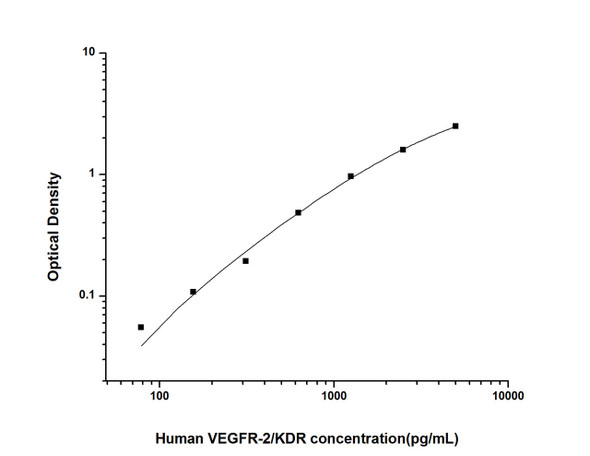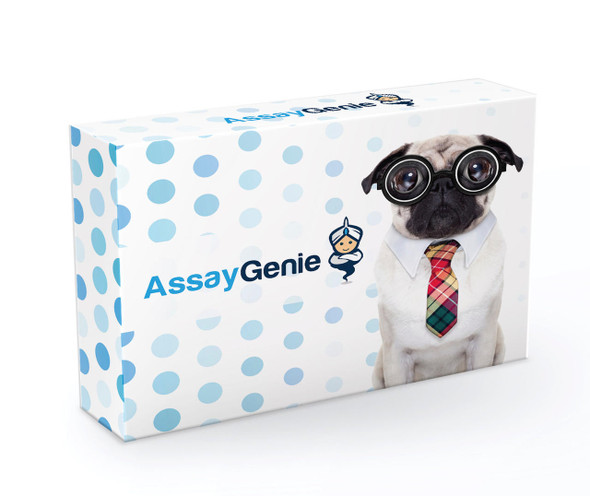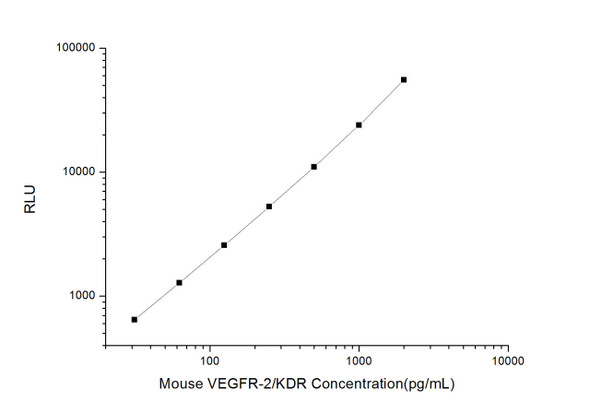Human Cardiovascular ELISA Kits
Human VEGFR-2/KDR (Vascular Endothelial Growth Factor Receptor 2) CLIA Kit (HUES00913)
- SKU:
- HUES00913
- Product Type:
- ELISA Kit
- ELISA Type:
- CLIA Kit
- Size:
- 96 Assays
- Sensitivity:
- 9.38pg/mL
- Range:
- 15.63-1000pg/mL
- ELISA Type:
- Sandwich
- Synonyms:
- VEGFR2, CD309, FLK1
- Reactivity:
- Human
- Sample Type:
- Serum, plasma and other biological fluids
- Research Area:
- Cardiovascular
Description
| Assay type: | Sandwich |
| Format: | 96T |
| Assay time: | 4.5h |
| Reactivity: | Human |
| Detection method: | Chemiluminescence |
| Detection range: | 15.63-1000 pg/mL |
| Sensitivity: | 9.38 pg/mL |
| Sample volume: | 100µL |
| Sample type: | Serum, plasma and other biological fluids |
| Repeatability: | CV < 15% |
| Specificity: | This kit recognizes Human VEGFR-2/KDR in samples. No significant cross-reactivity or interference between Human VEGFR-2/KDR and analogues was observed. |
This kit uses Sandwich-CLIA as the method. The micro CLIA plate provided in this kit has been pre-coated with an antibody specific to Human VEGFR-2/KDR. Standards or samples are added to the appropriate micro CLIA plate wells and combined with the specific antibody. Then a biotinylated detection antibody specific for Human VEGFR-2/KDR and Avidin-Horseradish Peroxidase (HRP) conjugate are added to each micro plate well successively and incubated. Free components are washed away. The substrate solution is added to each well. Only those wells that contain Human VEGFR-2/KDR, biotinylated detection antibody and Avidin-HRP conjugate will appear fluorescence. The Relative light unit (RLU) value is measured spectrophotometrically by the Chemiluminescence immunoassay analyzer. The RLU value is positively associated with the concentration of Human VEGFR-2/KDR. The concentration of Human VEGFR-2/KDR in the samples can be calculated by comparing the RLU of the samples to the standard curve.
| UniProt Protein Function: | VEGFR2: a receptor tyrosine kinase of the VEGFR family. High affinity receptor for VEGF and VEGF-C. Ligand binding induces autophosphorylation and activation. Activated receptor recruits proteins including Shc, GRB2, PI3K, Nck, SHP-1 and SHP-2. Plays a key role in vascular development and regulation of vascular permeability. |
| UniProt Protein Details: | Protein type:Protein kinase, TK; Kinase, protein; Membrane protein, integral; EC 2. 7. 10. 1; Protein kinase, tyrosine (receptor); TK group; VEGFR family Chromosomal Location of Human Ortholog: 4q11-q12 Cellular Component: Golgi apparatus; endoplasmic reticulum; integral to plasma membrane; early endosome; cytoplasmic membrane-bound vesicle; extracellular region; plasma membrane; cell junction; nucleus; endosome; lipid raft; external side of plasma membrane Molecular Function:integrin binding; vascular endothelial growth factor receptor activity; protein binding; growth factor binding; protein-tyrosine kinase activity; receptor signaling protein tyrosine kinase activity; Hsp90 protein binding; transmembrane receptor protein tyrosine kinase activity; ATP binding Biological Process: extracellular matrix organization and biogenesis; positive regulation of positive chemotaxis; peptidyl-tyrosine phosphorylation; viral reproduction; protein amino acid autophosphorylation; cell maturation; calcium ion homeostasis; regulation of cell shape; positive regulation of MAPKKK cascade; positive regulation of focal adhesion formation; ovarian follicle development; positive regulation of cell proliferation; positive regulation of mesenchymal cell proliferation; angiogenesis; vasculogenesis; endothelial cell differentiation; cell fate commitment; embryonic hemopoiesis; positive regulation of phosphoinositide 3-kinase cascade; positive regulation of angiogenesis; cell migration during sprouting angiogenesis; branching morphogenesis of a tube; positive regulation of endothelial cell proliferation; positive regulation of protein amino acid phosphorylation; lymph vessel development; vascular endothelial growth factor receptor signaling pathway; alveolus development; surfactant homeostasis; transmembrane receptor protein tyrosine kinase signaling pathway; negative regulation of apoptosis; positive regulation of cell migration; positive regulation of nitric-oxide synthase biosynthetic process Disease: Hemangioma, Capillary Infantile |
| NCBI Summary: | Vascular endothelial growth factor (VEGF) is a major growth factor for endothelial cells. This gene encodes one of the two receptors of the VEGF. This receptor, known as kinase insert domain receptor, is a type III receptor tyrosine kinase. It functions as the main mediator of VEGF-induced endothelial proliferation, survival, migration, tubular morphogenesis and sprouting. The signalling and trafficking of this receptor are regulated by multiple factors, including Rab GTPase, P2Y purine nucleotide receptor, integrin alphaVbeta3, T-cell protein tyrosine phosphatase, etc. . Mutations of this gene are implicated in infantile capillary hemangiomas. [provided by RefSeq, May 2009] |
| UniProt Code: | P35968 |
| NCBI GenInfo Identifier: | 9087218 |
| NCBI Gene ID: | 3791 |
| NCBI Accession: | P35968. 2 |
| UniProt Secondary Accession: | P35968,O60723, Q14178, A2RRS0, B5A925, C5IFA0, |
| UniProt Related Accession: | P35968 |
| Molecular Weight: | 79,634 Da |
| NCBI Full Name: | Vascular endothelial growth factor receptor 2 |
| NCBI Synonym Full Names: | kinase insert domain receptor (a type III receptor tyrosine kinase) |
| NCBI Official Symbol: | KDR |
| NCBI Official Synonym Symbols: | FLK1; CD309; VEGFR; VEGFR2 |
| NCBI Protein Information: | vascular endothelial growth factor receptor 2; soluble VEGFR2; fetal liver kinase 1; fetal liver kinase-1; protein-tyrosine kinase receptor Flk-1; tyrosine kinase growth factor receptor |
| UniProt Protein Name: | Vascular endothelial growth factor receptor 2 |
| UniProt Synonym Protein Names: | Fetal liver kinase 1; FLK-1; Kinase insert domain receptor; KDR; Protein-tyrosine kinase receptor flk-1; CD_antigen: CD309 |
| Protein Family: | Vascular endothelial growth factor receptor |
| UniProt Gene Name: | KDR |
| UniProt Entry Name: | VGFR2_HUMAN |
As the RLU values of the standard curve may vary according to the conditions of the actual assay performance (e. g. operator, pipetting technique, washing technique or temperature effects), the operator should establish a standard curve for each test. Typical standard curve and data is provided below for reference only.
| Concentration (pg/mL) | RLU | Average | Corrected |
| 1000 | 50856 56494 | 53675 | 53650 |
| 500 | 20574 24404 | 22489 | 22464 |
| 250 | 10622 9800 | 10211 | 10186 |
| 125 | 4469 5333 | 4901 | 4876 |
| 62.5 | 2547 2359 | 2453 | 2428 |
| 31.25 | 1336 1226 | 1281 | 1256 |
| 15.63 | 686 730 | 708 | 683 |
| 0 | 24 26 | 25 | -- |
Precision
Intra-assay Precision (Precision within an assay): 3 samples with low, mid range and high level Human VEGFR-2/KDR were tested 20 times on one plate, respectively.
Inter-assay Precision (Precision between assays): 3 samples with low, mid range and high level Human VEGFR-2/KDR were tested on 3 different plates, 20 replicates in each plate.
| Intra-assay Precision | Inter-assay Precision | |||||
| Sample | 1 | 2 | 3 | 1 | 2 | 3 |
| n | 20 | 20 | 20 | 20 | 20 | 20 |
| Mean (pg/mL) | 50.08 | 139.14 | 480.54 | 51.41 | 138.83 | 499.06 |
| Standard deviation | 5.13 | 14.86 | 52.62 | 5.07 | 15.05 | 32.89 |
| C V (%) | 10.24 | 10.68 | 10.95 | 9.86 | 10.84 | 6.59 |
Recovery
The recovery of Human VEGFR-2/KDR spiked at three different levels in samples throughout the range of the assay was evaluated in various matrices.
| Sample Type | Range (%) | Average Recovery (%) |
| Serum (n=5) | 90-104 | 97 |
| EDTA plasma (n=5) | 100-117 | 108 |
| Cell culture media (n=5) | 86-99 | 92 |
Linearity
Samples were spiked with high concentrations of Human VEGFR-2/KDR and diluted with Reference Standard & Sample Diluent to produce samples with values within the range of the assay.
| Serum (n=5) | EDTA plasma (n=5) | Cell culture media (n=5) | ||
| 1:2 | Range (%) | 86-99 | 91-104 | 89-104 |
| Average (%) | 92 | 96 | 97 | |
| 1:4 | Range (%) | 96-112 | 98-109 | 91-107 |
| Average (%) | 102 | 103 | 98 | |
| 1:8 | Range (%) | 102-117 | 87-101 | 91-102 |
| Average (%) | 108 | 94 | 97 | |
| 1:16 | Range (%) | 102-119 | 101-118 | 91-101 |
| Average (%) | 109 | 108 | 96 |
An unopened kit can be stored at 4°C for 1 month. If the kit is not used within 1 month, store the items separately according to the following conditions once the kit is received.
| Item | Specifications | Storage |
| Micro CLIA Plate(Dismountable) | 8 wells ×12 strips | -20°C, 6 months |
| Reference Standard | 2 vials | |
| Concentrated Biotinylated Detection Ab (100×) | 1 vial, 120 µL | |
| Concentrated HRP Conjugate (100×) | 1 vial, 120 µL | -20°C(shading light), 6 months |
| Reference Standard & Sample Diluent | 1 vial, 20 mL | 4°C, 6 months |
| Biotinylated Detection Ab Diluent | 1 vial, 14 mL | |
| HRP Conjugate Diluent | 1 vial, 14 mL | |
| Concentrated Wash Buffer (25×) | 1 vial, 30 mL | |
| Substrate Reagent A | 1 vial, 5 mL | 4°C (shading light) |
| Substrate Reagent B | 1 vial, 5 mL | 4°C (shading light) |
| Plate Sealer | 5 pieces | |
| Product Description | 1 copy | |
| Certificate of Analysis | 1 copy |
- Set standard, test sample and control (zero) wells on the pre-coated plate and record theirpositions. It is recommended to measure each standard and sample in duplicate. Note: addall solutions to the bottom of the plate wells while avoiding contact with the well walls. Ensuresolutions do not foam when adding to the wells.
- Aliquot 100 µL of standard solutions into the standard wells.
- Add 100 µL of Sample / Standard dilution buffer into the control (zero) well.
- Add 100 µL of properly diluted sample (serum, plasma, tissue homogenates and otherbiological fluids. ) into test sample wells.
- Cover the plate with the sealer provided in the kit and incubate for 90 min at 37 °C.
- Aspirate the liquid from each well, do not wash. Immediately add 100 µL of BiotinylatedDetection Ab working solution to each well. Cover the plate with a plate seal and gently mix. Incubate for 1 hour at 37 °C.
- Aspirate or decant the solution from the plate and add 350 µL of wash buffer to each welland incubate for 1-2 minutes at room temperature. Aspirate the solution from each well andclap the plate on absorbent filter paper to dry. Repeat this process 3 times. Note: a microplatewasher can be used in this step and other wash steps.
- Add 100 µL of HRP Conjugate working solution to each well. Cover with a plate seal andincubate for 30 min at 37 °C.
- Aspirate or decant the solution from each well. Repeat the wash process for five times asconducted in step 7.
- Add 100 µL of Substrate mixture solution to each well. Cover with a new plate seal andincubate for no more than 5 min at 37 °C. Protect the plate from light.
- Determine the RLU value of each well immediately.






